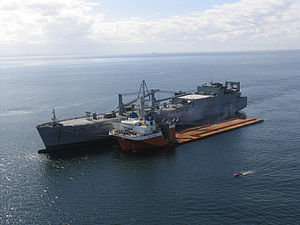This is an old revision of this page, as edited by Saberwyn (talk | contribs) at 03:17, 13 January 2011 (copyediting). The present address (URL) is a permanent link to this revision, which may differ significantly from the current revision.
Revision as of 03:17, 13 January 2011 by Saberwyn (talk | contribs) (copyediting)(diff) ← Previous revision | Latest revision (diff) | Newer revision → (diff) USNS Watkins (back) and heavy lift ship MV Mighty Servant 1 moor side-by-side off San Diego during a demonstration of the Mobile Landing Platform concept in 2005. USNS Watkins (back) and heavy lift ship MV Mighty Servant 1 moor side-by-side off San Diego during a demonstration of the Mobile Landing Platform concept in 2005.
| |
| Class overview | |
|---|---|
| Builders | General Dynamics |
| Operators | United States Navy |
| Planned | 3 |
| General characteristics | |
| Displacement | 34,544 metric tons (33,998 long tons; 38,078 short tons) |
| Length | 800 feet (240 m) |
| Speed | 20 knots (37 km/h; 23 mph) |
| Range | 9,000 nautical miles (17,000 km; 10,000 mi) |
| Troops | 1,112 marines |
| Complement | Unknown |
The Mobile Landing Platform (MLP) is a type of amphibious assault ship currently being planned for the United States Navy, with the first ship due to enter service in 2015. MLP ships are to serve as floating bases for amphibious operations, and operate as a transfer point between large ships and small landing craft. Proof-of-concept testing began in 2005, with heavy lift ships serving as substitutes for the MLPs. General Dynamics was awarded a contract to design and build the first ship in late 2010, and the United States Navy initially plans to acquire three vessels.
Design
The Mobile Landing Platform concept calls for a large auxiliary support ship to facilitate the 'seabasing' of an amphibious landing force by acting as a floating base or transfer station that can be prepositioned off the target area. Troops, equipment, and cargo would be transferred to the MLP by large-draft ships, from where it can be moved ashore by shallower-draft vessels, landing craft like the Landing Craft Air Cushion (LCAC), or helicopters.
The proposed ships will have a displacement of 34,544 metric tons (33,998 long tons; 38,078 short tons) and a length of 800 feet (240 m). They will be capable of sailing at 20 knots (37 km/h; 23 mph), with a maximum range of 9,000 nautical miles (17,000 km; 10,000 mi). Although the size of the ship's crew is unknown, the vessels will be capable of hosting 1,112 marines and their equipment. The MLPs will be based loosely on the design of the Alaska class oil tanker.
The MLP will also include ample space for the equipment used by troops aboard, including jeeps, helicopters, and mobile assault vehicles. It may also be able to accommodate future high-speed beach landing craft, currently being planned by the United States Navy. Using the ship, a US Stryker brigade could be deployed to a hostile country within a few days, including the 15,000–20,000 tonnes (15,000–20,000 long tons; 17,000–22,000 short tons) of equipment needed to support such a brigade.
Concept testing
In September 2005, the United States Navy approved trials of the MLP concept, to test the feasibility of seabasing for an amphibious operation. The heavy lift ship MV Mighty Servant 1 served as the substitute for the MLP, while the Roll-on/roll-off vessel USNS Watkins played the role of a planned type of transport ship for the United States Maritime Prepositioning Force. The first part of the trial consisted of the two ships transferring cargo between themselves while anchored in Puget Sound. After successfully completing this, the vessels sailed to San Diego, where cargo was transferred from Watkins to Mighty Servant 1, then taken ashore by LCACs; slightly submerging the deck of the heavy lift ship allowed the hovercraft to "'fly' aboard".
A second series of tests was conducted off Norfolk, Virginia in September and October 2006, with USNS Red Cloud and MV Mighty Servant 3. This time, the ships were moored together while underway, during which vehicles drove from Red Cloud onto Mighty Servant 3, then embarked aboard LCACs. In February 2010, Mighty Servant 3 joined USNS Soderman for further trials in the Gulf of Mexico, during which personnel and a wide range of vehicles, from Humvees to M1 Abrams tanks, in conditions up to Sea State 4.
Construction
In August 2010, General Dynamics in San Diego was awarded a US$115 million contract to design the Mobile Landing Platform, and build the first ship. Construction is due to begin in July 2011. The United States Navy initially plans to acquire three vessels, with the first operational by 2015.
References
- ^ "The US Navy's Mobile Landing Platform Ships". Defense Industry Daily. Watershed Publishing. 18 August 2010. Retrieved 12 January 2011.
- ^ "Mobile Landing Platform [MLP]". GlobalSecurity.org. Retrieved 13 January 2011.
- Robbins, Gary (14 August 2010). "General Dynamics gets $115M for 'pier at sea'". San Diego Union-Tribune. The San Diego Union-Tribune, LLC. Retrieved 10 January 2011.